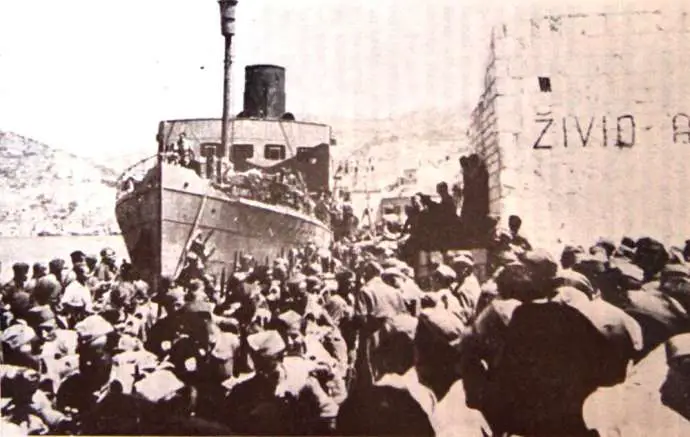In 1943 the first overseas brigade was formed in Carbonara, Italy. It consisted of 1886 fighters from the Slovenian 1st and 2nd battalions, 3rd Montenegrin battalion and 4th battalion, which was Croatian in origin. A month later when the brigade was deployed to the island of Hvar two more battalions joined in, mostly comprised of Slovenian soldiers.
In WWII fascist Italy arrested over 60,000 Slovenes from the occupied Western Slovenia and sent them to concentration camps as political prisoners, alongside several thousand Croats and Serbs. Furthermore about 10,000 Slovenes and Croats were mobilised and mostly deployed in penal work units or so-called special battalions as citizens of Italy, and an additional 6,000 antifascist activists from the Littoral and Istria, were sent to jails and special camps in the Italian hinterlands and islands, such as Lipari, Ustica and Ponza.
Italy capitulated in September 1943 and the internees came under the supervision of the occupying allied forces. Most of the Slovenes and other Yugoslavs located in the north of the country managed to escape to the Littoral and Istria, while the majority, located in the central and Southern Italy, were gathered by the Allies in various local camps and then moved to a single major camp in Carbonara near Bari, Italy.
Right after the capitulation of Italy, the National Liberation Army and Partisan Detachments of Yugoslavia (NLAPDY) delegation came to the camp and established its base there in agreement with the occupying Allied forces. The NLAPDY then negotiated to establish the self-organisation of life inside the camp and dismissed the Chetnik guards (mostly from the Serbian nationalist and royalist army, which collaborated with the Nazis on many occasions –- the main military force the Allies collaborated with in the territories of Yugoslavia until 1943). At the same time the camps committee of the Communist Party of Yugoslavia was established alongside the 1st. Overseas Brigade. In November of the same year the internees were moved to Gravina, which had its own command headquarters and guards, and was also a gathering point for all the subsequent arrivals of Yugoslavian expats, which continued to arrive there in the subsequent year.
The occupying powers and Marshal Badoglio, who was in charge of the Carbonara camp, disagreed on the transfer of former members of the Italian army – mobilized Slovenes and Croats – to the Yugoslav National Liberation Army, causing more of them to flee from Allied assembly camps to NLAPDY assembly points in Taranto, Naples, Foggia, Brindisi and then to Gravina.
About 20,000 of the Littorals and Istrians, who were not in contact with the NLAPDY during the liberation of Italy in Sardinia, were transferred to Corsica in spring 1944 and then to southern France, where they were detained until December 1945.
After being mobilized into the Italian army thousands of Littorals and Istrians were sent to the Italian occupied territories in African Ethiopia, Somalia, Eritrea and Libya. They were captured there by Allied troops and imprisoned in prison camps in Kenya, Sudan, Egypt, Algeria and some other countries. From there, after the invasion of Yugoslavia in April 1941, they joined the emerging Yugoslav royal army abroad. The latter lost homogeneity as a result of the controversial emigration of the Yugoslav government and the dual policy of General Draza Mihailović, and by that time a large part of these troops had also joined the NLAPDY overseas brigades in Italy.
Nazi Germany also mobilized Slovenes from its occupied territories of the Upper Carniola (Gorenjska), Styria (Štajerska) and Carinthia (Koroška), many of whom crossed over to the Allies after the invasion of Normandy in June 1944. Two thousand eight hundred of them established an overseas brigade in London.
In the years of 1943 and 1944, five overseas brigades were formed, and several other artillery and special units that participated in the fight against the occupying forces in Yugoslavia. In all the overseas units consisted of about 18,000 troops, more than 1,000 of whom fell in battle.
In December 1943, the 1st Overseas Brigade was transferred to the island of Korčula to defend it on December 22- 24, 1943, when the Germans landed on the island. The brigade suffered heavy casualties and retreated to Vis. Subsequently, members of the 1st Overseas Brigade participated in the seventh offensive and landing on Drvar, and then were deployed to Serbia, where they participated in the fight for the liberation of Belgrade. Following this operation, the 1st and 6th Proletarian Divisions, whose members had previously been members of the 1st Overseas Brigade, participated in the Srem front, then advanced through Slovenia towards Trieste.






